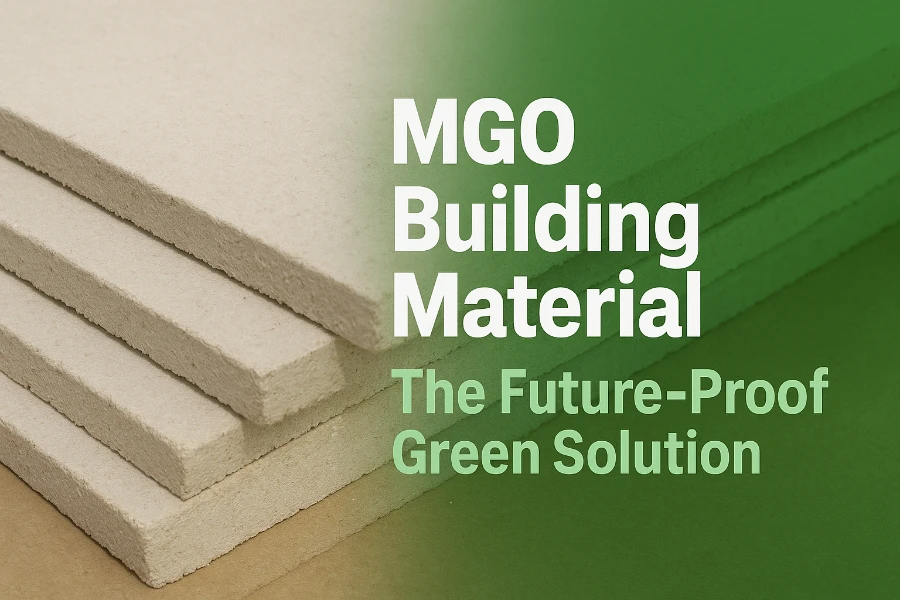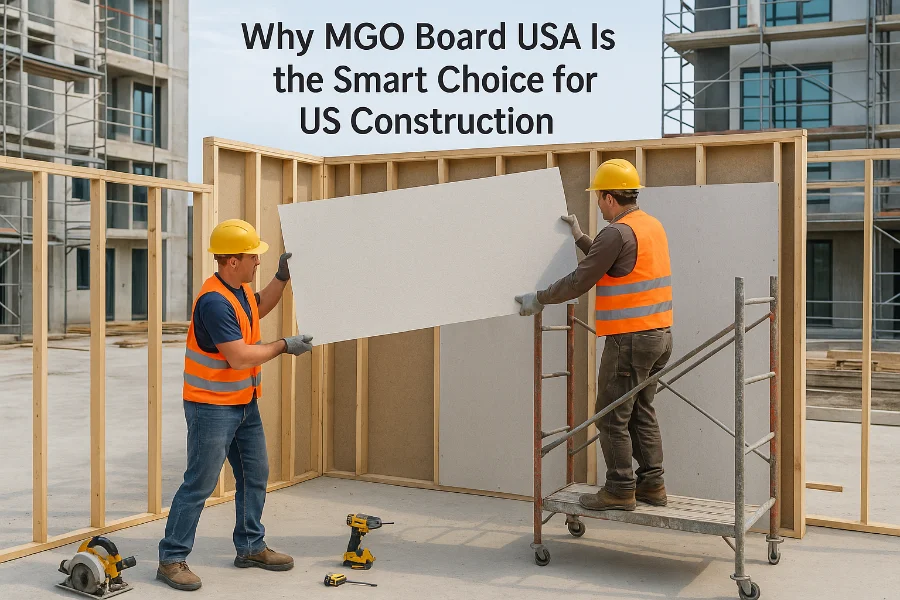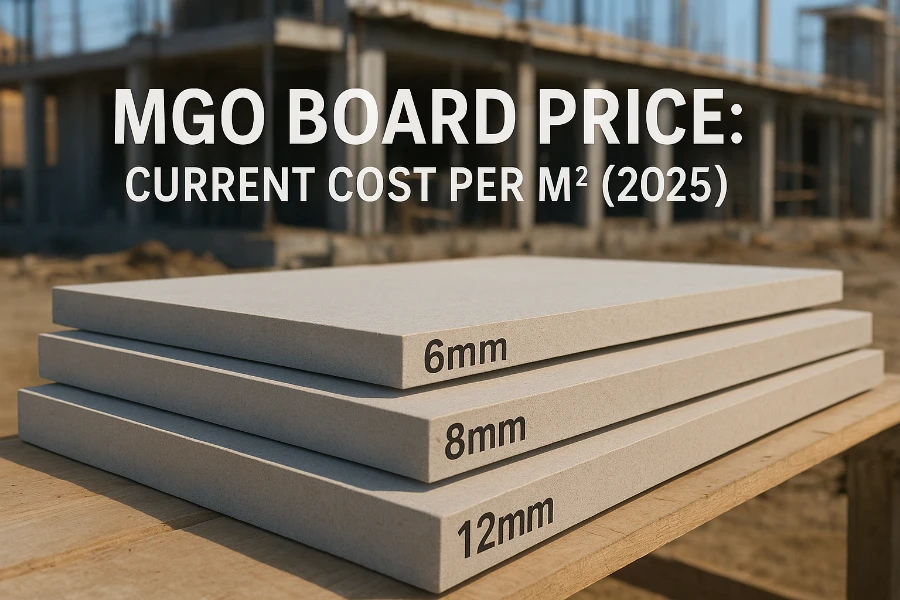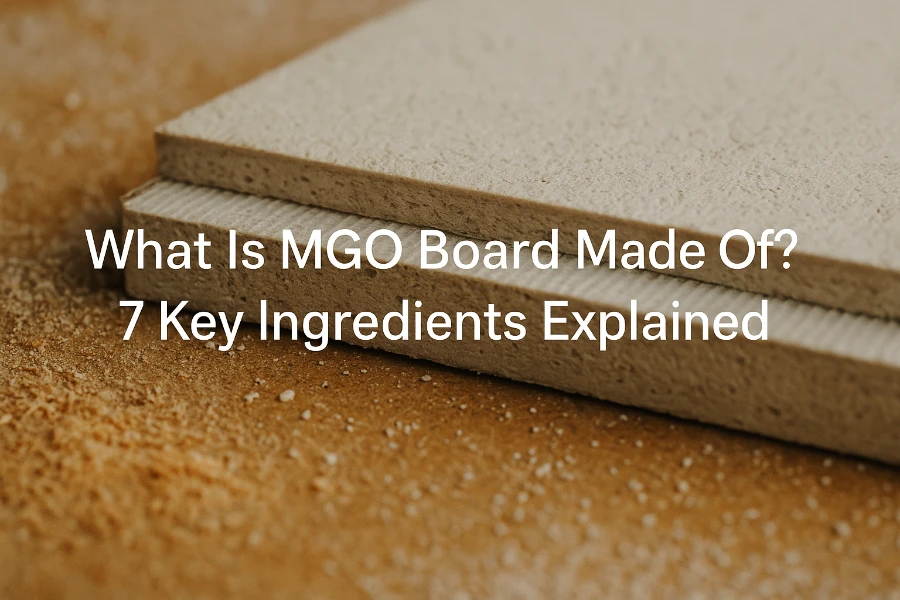Table of Contents
Introduction
In today’s construction world, sustainability and safety are no longer optional—they’re essential. Builders, architects, and property owners are looking for materials that perform well under pressure while minimizing environmental impact. Among the many alternatives available, MGO building material has emerged as one of the most promising solutions.
Known for its remarkable strength, fire resistance, and eco-friendly composition, MGO (magnesium oxide) board is revolutionizing how modern structures are designed and built. It stands at the intersection of durability and sustainability—a truly future-proof green solution for the next generation of construction projects.
What Is MGO Building Material?
Composition and Core Ingredients
At its core, MGO building material is made from a carefully balanced blend of magnesium oxide, magnesium chloride or magnesium sulfate, fiberglass mesh, perlite, and other natural fillers. When combined, these components form a strong crystalline matrix that provides both rigidity and flexibility.
Unlike gypsum board, which relies heavily on paper liners and chemical additives, MGO boards are mineral-based and completely inorganic. This makes them highly resistant to mold, moisture, and pests. Moreover, MGO boards emit no VOCs (volatile organic compounds), ensuring indoor air quality remains safe and healthy.
How It Differs from Traditional Materials
When compared to traditional options like gypsum board, OSB, or plywood, mgo building material clearly stands out. It is non-combustible, stronger under compression, and unaffected by humidity changes. While gypsum tends to crumble in damp conditions and OSB can swell or warp, MGO building material remains dimensionally stable.
It’s also a safer alternative to asbestos-based panels, offering equal fireproofing performance without the health hazards. The combination of environmental safety and structural performance makes it a preferred choice for green builders worldwide.
Key Advantages of MGO Building Material
Fire Resistance and Safety
One of the most impressive attributes of MGO is its fire resistance. Tested under ASTM and EN standards, it can withstand temperatures exceeding 1000°C without structural failure. It doesn’t burn, release toxic fumes, or contribute to flame spread. For public buildings, schools, hospitals, and residential towers, this property alone makes it invaluable.
Moisture and Mold Resistance
Unlike gypsum or wood-based products, MGO’s inorganic composition means it doesn’t absorb moisture easily. It’s ideal for humid environments such as bathrooms, basements, or coastal buildings. Even after prolonged exposure to water, it won’t soften, swell, or grow mold—maintaining both appearance and performance.
Strength and Durability
Another advantage of MGO building material is its exceptional compressive and bending strength. It offers a stable surface for tiling, painting, or laminating while resisting impact damage. Because of its dense internal structure, MGO boards experience minimal shrinkage or deformation over time, extending the building’s lifespan and reducing maintenance costs.
Eco-Friendly and Non-Toxic Properties
Sustainability is at the heart of MGO’s appeal. Unlike cement boards, which require high energy during production, MGO boards are manufactured at lower kiln temperatures—meaning less CO₂ emission. They contain no formaldehyde, asbestos, or other harmful chemicals, making them safe for both workers and occupants. Many projects using magnesium oxide building materials qualify for green building certifications due to their low environmental footprint.

MGO and the Future of Sustainable Construction
Supporting Green Building Certifications
With global awareness growing around sustainability, MGO boards are increasingly recognized in certification systems such as LEED (Leadership in Energy and Environmental Design) and BREEAM. Their recyclable nature, energy-efficient production, and durability all contribute to earning green credits.
Developers seeking long-term environmental compliance are turning to MGO building material as a credible, certification-friendly option.
Reducing Carbon Footprint in Building Projects
MGO manufacturing consumes less fuel and emits significantly fewer greenhouse gases compared to Portland cement. During installation, MGO panels also reduce material waste due to their precision cutting and minimal breakage. Over time, buildings that use magnesium oxide panels require fewer repairs, indirectly cutting down on transportation and disposal emissions.
Long-Term Cost Efficiency
While the initial price of MGO boards may be slightly higher than gypsum board, the long-term savings are substantial. Their durability, fireproof nature, and resistance to moisture drastically reduce replacement frequency. For commercial projects, hospitals, or schools that prioritize life-cycle value, MGO offers a measurable return on investment.
Common Applications of MGO Building Material
Because of its versatility, MGO is suitable for a wide range of structural and decorative uses. Common applications include:
-
Subflooring and underlayment systems
-
Interior and exterior wall panels
-
Ceiling boards and fireproof partitions
-
Roof sheathing and soffits
-
Prefabricated houses, modular buildings, and container homes
-
Public infrastructure like airports, schools, and hospitals
In each of these cases, MGO building materials provide a durable, lightweight, and environmentally responsible alternative to traditional substrates.
Choosing the Right MGO Board for Your Project
Selecting the right type of MGO board depends on where and how it will be used. For indoor walls or ceilings, a medium-density board with a smooth finish works best. For exterior cladding or flooring, a high-density, water-resistant board is recommended.
Always verify key parameters such as density, thickness, fire rating, and moisture performance before purchase. It’s equally important to work with a reliable MGO board supplier—one with consistent quality control, technical support, and export experience.
Suparna MgO Board, for instance, offers a wide range of magnesium oxide building materials tailored for global markets, ensuring dependable quality backed by years of manufacturing expertise.
Conclusion: Why MGO Is the Future-Proof Green Solution
In a world shifting rapidly toward sustainability and safety, MGO building material stands out as the ultimate future-proof solution. Its ability to resist fire, moisture, and decay—while supporting a healthier planet—makes it a cornerstone of next-generation construction.
Whether you’re designing a high-rise, a modular home, or a green-certified project, MGO delivers performance that lasts. It’s not just a board—it’s a smarter way to build.
👉 Looking for a trusted MGO board supplier?
Contact Suparna MgO Board today to request samples or a quotation, and experience the future of green construction firsthand.
Discover why MGO board USA is the smart choice for American construction—fire-resistant, durable, eco-friendly, and compliant with US building standards.
Discover the current MGO board price per m² in 2025. Learn factors affecting cost, compare with fiber cement boards, and get tips to save on your project.
Discover what MGO board is made of: 7 key ingredients including MgO, MgCl₂ or MgSO₄, sawdust, perlite, fiberglass, and non-woven fabric.




